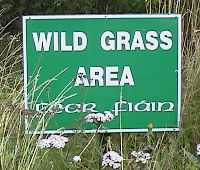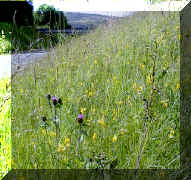|
Wildflower
Grass Area
When not to sow grasses with wildflowers

If you are sowing a meadow of less than one acre in size (4047m2) grasses need not be sown with wildflower mixtures as the grass can take over and may cause more work. in the early years you will have
to cut more and get less flowers.
Grass seeds mixed with wild flora works well in most cases, provided the grasses are
sown at the correct
rate, suitable to grow with wildflowers and are sown at the appropriate rate.
Wildflowers mixed with grasses on certain Irish soils
On certain Irish soils wildflowers mixed with grasses do not perform well as the soil is too rich, and wet, in such a case, grass tends to out grow the wildflowers. On rich & wet soils grasses can be
sown to control vigorous weeds but at low rates to allow wild flowers to grow. At this point we are all learning, but the general rule is, allow the weed gene-bank to grow, identify the weeds and if there is not to many Dock's, Scutch
and nettles, sow lightly with the grasses, if there are lots of unwanted weeds, reassess growing wildflowers or cultivate /spray to reduce the worst weeds.
- Except on steep slopes, grasses tend to outgrow the wildflowers.
- Grasses can also grow too vigorously for wild flora due to high moisture levels.
- Maintenance costs may also be higher.
- Vigorous agricultural strains of grasses are far too strong to grow with wildflowers. Also avoid all ryegrass, as it will smother wildflowers.
- It can be more expensive to use grasses with wild flowers, as grasses will need to be cut more often. The increased cost of cutting grass may become more than is affordable.
- An alternative to using grass is to sow 100% pure wild flora.
- You can with extra annuals or perennial species sown at higher rates to give a more grassy effect. See also my new MMF range.
- Annuals used as a nurse crop will flower in the first years and require less cutting than grasses.

Wildflower & Grass
Species
Some grass species supplied in Design By Nature mixtures:
Common or Brown Top Bent Agrostis capillaris
= A. tenuis.
Creeping Bent Agrostis stolonifera = A.
palustris
Highland Browntop Bent : Agrostis castellana
Chewings Fescue : Festuca Rubra 'Commutata'
Meadow Fescue: Festuca pratensis
Also available: Cocksfoot, Timothy, Yorkshire Fog, Crested Dogs Tail, Smooth Stalked Meadow Grass, Brown Top Bent and Hard Fescue
Special mixtures with any ratio of grasses and the corresponding amount of flora can be made to order based on your requirements. Mixtures are generally premixed prior to delivery.
All mixtures with grass are 'grower preferred' ratios.
Use them for different situations.
The rule is the more grasses seed used the more cutting and higher maintenance in the early years, the less grass used the more
flowers in the early years, but winter green is poor and after year 3 vigorous grasses may invade and cause problems.
Reasons to sow grass seed with wildflowers:
- Sow grasses with wild flora on Dry or fertile sites to reduce fertility and restrict weeds. Cutting will be required more often. On such sites with the regular cutting
and removal of grass you will get a less flowery meadow in the first three years. Seed and maintenance cost will also be higher.
- Sow grasses with wild flora on Wet fertile sites to restrict weeds. Cutting will be required more often. The regular cutting and removal of grass you will get a less
flowery meadow in the early years.
- Sow grass mixtures on very infertile sub-soil or 'second soil' (roads) or where soil
erosion needs to be controlled.
- Sow for rapid germination where desirable or as a
nurse crop on difficult sites esp.' slopes to help establish wildflowers.
- Sow to reduce toxicity or improve soil humus content.
- Sow grasses for agriculture and grazing, especially pasture.
- Sow to recreate specific floras such as pasture or hay meadow
- Sow to protect specific wild flora or host specific wildlife such as butterfly, skylarks or for nesting Corncrake. (seek advice)
- Sow to control existing rampant weeds & reduce nitrogen
- Sow grass/flora for amenity plantings or visual impact reasons
-
Special Note on Freshly Cut Grass.
Notes:
Fresh green grass cuttings must always be removed within hours after cutting. Golden hay cuttings can be left to dry out before removal. It may be beneficial to leave hay cuttings for about 3 days so
that the wildflowers will shed their seed. If you choose this option, ensure you, or your staff return to collect the Hay. If you doubt they will, remove it. Rake the soil after removal to encourage seedlings.

Can I sow directly into existing grasses?
Unless skilled and for special reasons. Most of our wildflower seed mixtures are not intended to establish if sown directly into existing grassy swards.
Seek advice and sow only if you are
competent using specialist seed mixtures, machinery or sowing approaches using 'Surface Sowing'.
'Surface Sowing' is really only required to introduce new species into old native grassland or to avoid erosion where the grass cannot be removed. (Cowslip, Rattle and Lesser Knapweed grow well)
Planting wildflower plugs into short grass is also effective. I can direct you through the difficult process of 'Surface sowing' as every site and situation
will be different.
Growing Instruction: Natural succession
'Meadow Meditation' In the wild, meadows take years to evolve. Wildflowers usually follow a clear succession in becoming a meadow. The wildflower growers aim is to regularly cut a meadow at least one or
twice per year to halt the succession and spread of grasses, shrubs or even trees. The secret of growing a great meadow falls to halting its natural succession just before the taller tougher grasses take over and the 'meadow starts
thinking it's a forest'. In nature, Annual species grow first, then Biennials flower in the second year. Perennial herbaceous plants and fine grasses then succeed these. In time in an uncut meadow taller tougher grass
species arrive & kill the flora. We must cut to control the spread of these grasses, as they cannot survive regular cutting. Annuals and Biennials die off and do not reappear unless they are species suited to growing in
grassland. Where semi-parasitic annual species of old hay meadows such as Bartsia, Eyebright, Loosewort or Yellow Rattle (grass dependent species) are supplied in our non-grass mixtures, a host grass at 0.5%/ will be included
in pure 100% wildflower mixtures. Yellow Rattle reduces the growth of grass and is essential to most meadows, it can be over sown into existing grassland and needs low temperatures to germinate. All the above species are
disappearing in the wild.
|